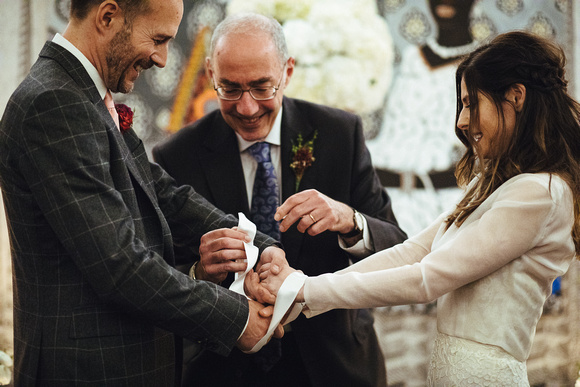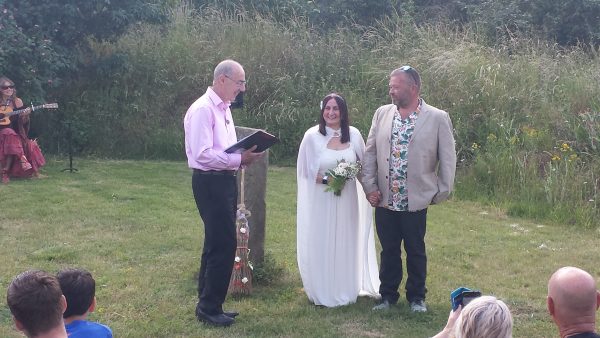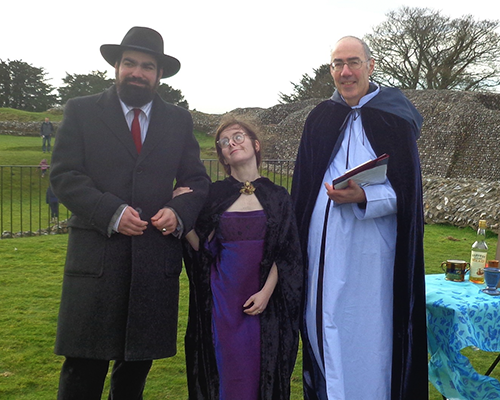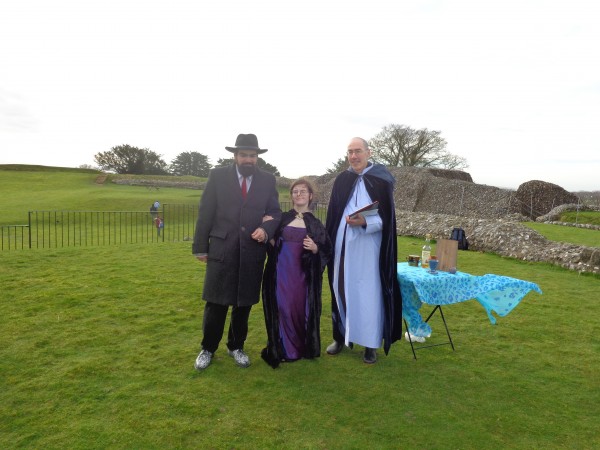
by Michael | Mar 8, 2022 | Blog
Although a lot of people have heard of “handfasting”, most don’t know what it is. So they don’t consider including it in their ceremony. It’s a lovely ritual, and they may be missing out.
Origin
Yes, it’s pagan, but if the thought of “pagan” conjures up visions of biting off the heads of live chickens, think again! This is a nature-related ritual, and nobody and nothing gets harmed!
Handfastings date back to the Middle Ages. They were originally a marriage rite, an alternative to the expense of a clergyman. So they were mostly for peasants.
What happened was that a cord was wrapped round the couple’s wrists until their union was consummated. (They would then keep it as a token of their commitment and love.)
Nowadays
Today, the symbolism remains the same. However, there are essentially two types of handfasting. One is the climax of an entire service; the other will just be an element in a ‘normal’ ceremony.
You have free choice of the type of cord you use. I advise one that is at least a metre long (to give me a chance to tie it successfully!). You can choose the colour or type. There are different ways of knotting – I prefer the figure of eight way (representing infinity).
Let’s see what the full service might look like.
What it is
There are no hard-and-fast rules about what goes in to the full service. Your celebrant can advise. Most ceremonies will include the following:
Sanctifying the Circle – symbolises the womb of Mother Earth – we make the wedding site a holy place.
Elemental blessings – these enable us to appreciate how the four elements help us on our journey.
Loving Cup – symbolises drinking in the promises or vows the couples have made.
Handfasting – the symbolic binding of the hands. This inspired the terms “bonds of holy matrimony” and “tying the knot”.
Jumping the Broom – another old custom (probably related to American slave weddings) symbolising the creation of hearth and home together.
Why include the handfasting?
The handfasting words and act are beautiful. They make the ceremony stand out, as the whole ritual is very special. For many people, the connection with nature is highly important. But there’s nothing wrong with simply including something that is different to the norm.
Whatever the reason for including it, you are welcome to discuss it with me. Just give me a call.
Photo: www.lyndseygoddard.com

by Michael | Apr 29, 2019 | Blog
Unless you’re a Pagan, it may have escaped you
that today is Beltane. It’s a fire ritual and has some interesting traditions.
What is it?
Beltane is a fire festival, and originates
from the Celtic God ‘Bel’, meaning ‘the bright one’ and the Gaelic word ‘teine’,
meaning fire.
Beltane honours life. Taking place on 30th
April, it represents the peak of Spring and the beginning of Summer. The theme
is fertility.
On the eve of the month of May, the sexuality
of life and the earth is at its peak.
The Maiden goddess has reached her fullness.
She is the manifestation of growth and renewal. She can be known as Flora, the
Goddess of Spring, the May Queen or the May Bride.
The Young Oak King or Jack-in-the-Green or the
Green Man falls in love with her and she accepts him.
The May Queen falls pregnant.
The couple are symbols of the Sacred Marriage,
the union of Earth and Sky. This is the night of the Greenwood Marriage.
Beltane traditions
As this is a fire festival, bonfires are lit to honour the sun and
encourage the support of Bel and the Sun’s light to prosper the coming harvest
and protect the community.
Traditionally, all fires in the community would have to be extinguished. Then a special fire, known as ‘tein-eigen’, or ‘need-fire’ is kindled for Beltane.
,People would jump the fire for cleansing, purification, and fertility. Some couples would jump together (to pledge continuing fidelity) and cattle and other animals would be driven through the smoke as a protection against disease and to bring fertility.
Finally, the villagers would take some of the Tein-eigen to start their own fires again.
Ceremonies
As Beltane celebrates the Great Wedding of the Goddess and the God, it
is a popular time for pagan weddings or handfastings.
If you would like to find out more about how you can mark Beltane, it’s possibly a little late now! However, if you’d like to consider a handfasting, then please get in touch!
For some ideas, please have a look at my YouTube channel (and subscribe!): https://www.youtube.com/channel/UC1wWfxIZw0VpZLbHrJAbV6A?view_as=subscriber

by Michael | Apr 19, 2019 | Blog
It’s festival season at the moment! Whether you’re Christian or Jewish, there’s plenty going on. (Sorry if I’m unaware of other religious festivals that may be coinciding!)
Obviously, I’m
talking about Easter and Passover. The two are connected, of course. They both
last quite a while and the Last Supper was a Passover meal. Both
religions include eggs in their festivities (a symbol of Spring).
Despite
appearances, I wasn’t really intending to talk about the festivals themselves.
But I did want to have a religious slant to my blog at such a time.
A big question
People often ask me about my religious beliefs. How can I offer mixed-faith ceremonies? Even if I believe in either of the two religions, what about the other one(s)? And, as I’m not ordained, surely I can’t legitimately conduct such ceremonies?
Valid questions, and ones I have had to think hard about.
A small answer!
Let me take the last point first. I do not see that being a lay person prevents me from uttering holy words. I always tell my clients at the outset that I am not ordained and make no pretence about it. Moreover, even if I do not necessarily believe all the tenets of a particular religion, I feel happy enough to say the words. The words must not offend me, of course. I approve of a lot of Buddhist philosophy, so, though no Buddhist myself, would be happy to read appropriate texts.
When I was asked to do my first pagan ceremony (half a dozen years ago), my first reaction was “no!”. I had no intention of biting the head off a chicken, or whatever!
However, when I looked into it, I realised that paganism is nothing like that. It’s nature-centred and many of the prayers are really beautiful. I accepted the invitation. In fact, I greatly enjoyed the ceremony, and was so glad I had agreed to take it on.
Integrity
So that’s my answer to those questions. I don’t feel I’m being a hypocrite by reading words that I may not fully endorse. They are still valuable and valid. I’m not forcing myself to say words that upset me. I’m not misleading anybody into believing that they are booking a full-blown priest (or whatever). Moreover, I’m increasing my knowledge and understanding of other cultures, and that has got to be for the good.
So, without
remorse, let me sincerely wish you a very happy Easter or Passover!

by Michael | Mar 5, 2019 | Blog
So what’s it all about?
I often get
asked what a handfasting is.
Do you remember when Prince William married Kate Middleton? Although the ceremony was religious, they briefly incorporated a ritual that resembled a handfasting. The Archbishop draped ribbons over the clasped hands of the couple.
So much else
was going on that it attracted little attention. In fact, a handfasting is
technically pagan, and can play a central role in pagan ceremonies.
However, it is often chosen as an “add-on” in a more traditional wedding.
A number of brides and grooms are intrigued by this and have decided to incorporate this in their wedding.
Of course, it can be included in a Vow Renewal too.
History
Handfastings
began as a marriage rite in the Middle Ages. When peasants married, they might
have been unable to afford a clergyman’s fee to hear their vows or a ring to
signify their love. The ritual of handfasting became a popular alternative.
A cord was wrapped round the wrists of the couple and left on until their union was consummated. It would usually be kept as a tangible reminder and proof of their commitment and love.
It has given
us the expression “tying the knot”.
Present-day Ceremony
Nowadays, the cord symbolises the pair’s mutual love. The way a handfasting can be slipped in to a service is as follows. Please note that this is only a suggestion, and it will be rather different for a pagan ceremony.
- Walking down the aisle to be given away by a parent
- Celebrant welcome
- Meaning of love (possibly from a religious slant, if that’s wanted)
- Here, or after the Handfasting, or at both times, a song or a reading/poem
- Handfasting
- Possibly, a Unity Candle or Sand Ceremony or Chalice ritual
- Exchange of Rings/Vows
- Jumping the Broom (not actually pagan, but deriving from wedding ceremonies conducted by slaves in the American South), now used to symbolise sweeping in the new as a new home is created
- Concluding words
Thoughts
I conducted a memorable handfasting at an Iron Age Fort in Wiltshire. The ceremony was part-pagan, part-Jewish with rituals from both sides. (Of course, the symbolism was explained as we went along.)
It was a
totally unique occasion – absolutely perfect for the couple and – clearly – for
the guests too.
Another
example was when I shared a wonderful experience with an American couple at
Stonehenge at the time of the solstice – and that was quite unforgettable!
Otherwise, I
have performed handfastings indoors, and they were just as satisfying!
To add extra sparkle and personality to your big day, do find out about a handfasting. It will be a pleasure for me to tell you more.
Photo: www.lyndseygoddard.com
Please check out my improved YouTube channel and subscribe! https://www.youtube.com/channel/UC1wWfxIZw0VpZLbHrJAbV6A?view_as=subscriber

by Michael | Oct 9, 2018 | Blog
Clearly, a lot of people really don’t know what a handfasting is. A few words of explanation shouldn’t go amiss, then.
A handfasting forms a central part in pagan ceremonies, but is often chosen as a colourful “extra” in a more traditional wedding. In that case, it may only last a minute or so.
Brief it might be, but it is something well worth considering.
History
Handfastings originated in Celtic times, but began as a marriage rite in the Middle Ages. When peasants married, they were often unable to afford a clergyman’s fee to hear their vows or to buy a ring to signify their love. The ritual of handfasting became a popular alternative.
A cord was wrapped round the wrists of the couple and left on them until their union was consummated. It would usually be kept afterwards as a tangible reminder and proof of their commitment and love.
This ceremony has, of course, given us the expression “tying the knot”.
Present-day Ceremony
Nowadays, the cord symbolises the pair’s mutual love. The way a handfasting can be slipped in to a traditional-type wedding is as follows, although this is only a suggestion, and it will be different for a full pagan ceremony.
This could be the order of service:
- Bride walking down the aisle with her father
- Officiant welcome
- Address about the meaning of love (possibly from a religious slant, if that’s wanted)
- Optionally, the couple’s ‘story’
- Here, or after the Handfasting, or at both times, a song or a reading/poem
- Handfasting
- Possibly, a Unity Candle, Sand Ceremony or Chalice ritual
- Exchange of Rings/Vows
- Jumping the Broom (not actually pagan, but deriving from wedding ceremonies conducted by slaves in the American South), now used to symbolise sweeping in the new as the new home is created
- Concluding words
Thoughts

As a celebrant, perhaps my favourite handfasting was part-pagan, part-Jewish containing rituals from both sides. Of course, I explained the symbolism for those unfamiliar with the other’s practices, so everyone could understand. For example, the bride walked round the groom seven times while the groom recited his wife’s virtues (Jewish tradition), before we did the pagan handfasting.
This worked really well and helped create a warm atmosphere. It was a totally unique occasion – absolutely perfect for the couple and – clearly – for the guests too.
It’s something your civil celebrant will be able to advise you about.
If you want to add extra sparkle and personality to your big day, you could do a lot worse than try a handfasting.
Featured image: courtesy of www.lyndseygoddard.com




